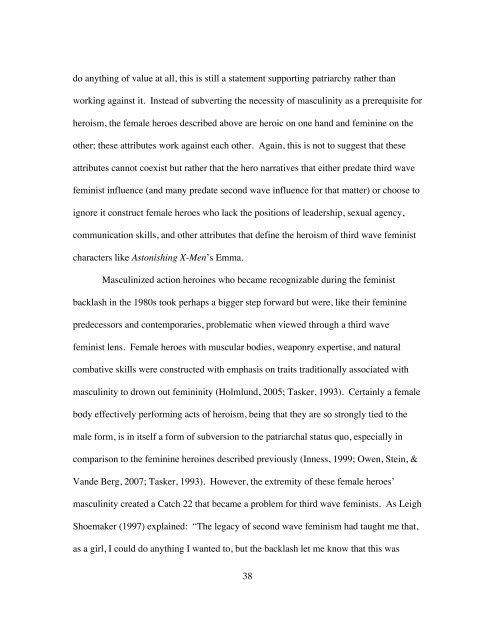Gender, Feminism, and Heroism in Joss Whedon and John ...
Gender, Feminism, and Heroism in Joss Whedon and John ...
Gender, Feminism, and Heroism in Joss Whedon and John ...
Create successful ePaper yourself
Turn your PDF publications into a flip-book with our unique Google optimized e-Paper software.
do anyth<strong>in</strong>g of value at all, this is still a statement support<strong>in</strong>g patriarchy rather than<br />
work<strong>in</strong>g aga<strong>in</strong>st it. Instead of subvert<strong>in</strong>g the necessity of mascul<strong>in</strong>ity as a prerequisite for<br />
heroism, the female heroes described above are heroic on one h<strong>and</strong> <strong>and</strong> fem<strong>in</strong><strong>in</strong>e on the<br />
other; these attributes work aga<strong>in</strong>st each other. Aga<strong>in</strong>, this is not to suggest that these<br />
attributes cannot coexist but rather that the hero narratives that either predate third wave<br />
fem<strong>in</strong>ist <strong>in</strong>fluence (<strong>and</strong> many predate second wave <strong>in</strong>fluence for that matter) or choose to<br />
ignore it construct female heroes who lack the positions of leadership, sexual agency,<br />
communication skills, <strong>and</strong> other attributes that def<strong>in</strong>e the heroism of third wave fem<strong>in</strong>ist<br />
characters like Astonish<strong>in</strong>g X-Men’s Emma.<br />
Mascul<strong>in</strong>ized action hero<strong>in</strong>es who became recognizable dur<strong>in</strong>g the fem<strong>in</strong>ist<br />
backlash <strong>in</strong> the 1980s took perhaps a bigger step forward but were, like their fem<strong>in</strong><strong>in</strong>e<br />
predecessors <strong>and</strong> contemporaries, problematic when viewed through a third wave<br />
fem<strong>in</strong>ist lens. Female heroes with muscular bodies, weaponry expertise, <strong>and</strong> natural<br />
combative skills were constructed with emphasis on traits traditionally associated with<br />
mascul<strong>in</strong>ity to drown out fem<strong>in</strong><strong>in</strong>ity (Holmlund, 2005; Tasker, 1993). Certa<strong>in</strong>ly a female<br />
body effectively perform<strong>in</strong>g acts of heroism, be<strong>in</strong>g that they are so strongly tied to the<br />
male form, is <strong>in</strong> itself a form of subversion to the patriarchal status quo, especially <strong>in</strong><br />
comparison to the fem<strong>in</strong><strong>in</strong>e hero<strong>in</strong>es described previously (Inness, 1999; Owen, Ste<strong>in</strong>, &<br />
V<strong>and</strong>e Berg, 2007; Tasker, 1993). However, the extremity of these female heroes’<br />
mascul<strong>in</strong>ity created a Catch 22 that became a problem for third wave fem<strong>in</strong>ists. As Leigh<br />
Shoemaker (1997) expla<strong>in</strong>ed: “The legacy of second wave fem<strong>in</strong>ism had taught me that,<br />
as a girl, I could do anyth<strong>in</strong>g I wanted to, but the backlash let me know that this was<br />
38

















